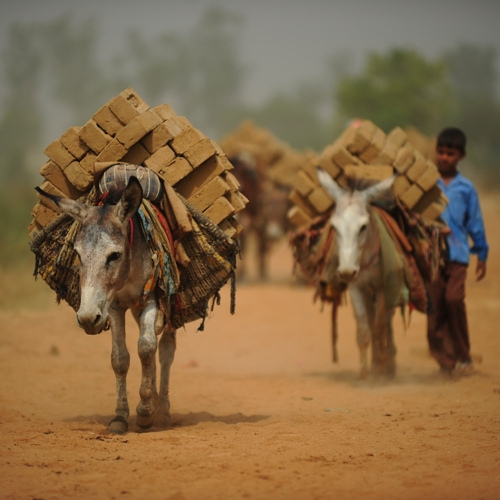Working Donkeys - Abuse in Brief.
The donkey or ass, Equus africanus asinus, is a domesticated member of the horse family, Equidae. The wild ancestor of the donkey is the African wild ass, E. africanus. The donkey has been used as a working animal for at least 5000 years. There are more than 40 million donkeys in the world, mostly in underdeveloped countries, where they are used principally as draught or pack animals. Working donkeys are often associated with those living at or below subsistence levels. Small numbers of donkeys are kept for breeding or as pets in developed countries.
Donkeys have been used as working machines since 3000 BC of which they are still used today within developing countries and non-developing countries. The brick kiln donkeys of Nepal is one prime example of animal exploitation that sees donkeys pushed to their limits all for consumer power.
Typically brick kilns only operate in the dry season and shut down during the rains. Most animals return with their owners to their original homes but the cost of transportation is high - as much as £14 each. Back in 2013 Dr. Bodh Prasad Parajuli, Chief of Central Animal Quarantine Office stated ‘This is awful.” That was the reaction of Dr. Bodh Prasad Parajuli, Chief of Central Animal Quarantine Office, when he saw the conditions of working equines in brick factories on April 29, 2013. The government chief visited Santaneshwor Brick Factory, among Lalitpur’s worst fourteen brick factories employing equines.
Dr Parajuli warned the equine owners that equine abuse cannot be accepted by his Department. He also realized the owners do not possess the required health cards. Animal Nepal has urged government authorities such as Department of Livestock Services, Animal Health and Quarantine to address the issue of equine abuse in brick factories.
Dr Parajuli agreed to promote detailed monitoring in quarantine check posts and is to activate the Veterinary Council of Nepal and Nepal Veterinary Association to stop the distribution of health certificates for unhealthy equines. It is agreed that a joint meeting with the various government agencies will be held to address the problems in an effective and lasting manner. Animal Nepal requested Dr Parajuli to strictly follow existing regulations, especially when equines are imported from India, and to improve conditions during the transportation of equines from Kathmandu to Nepalgunj and vice versa.
Asses were first domesticated around 3000 BC, probably in Egypt or Mesopotamia, and have spread around the world. They continue to fill important roles in many places today. While domesticated species are increasing in numbers, the African wild ass and another relative, the onager, are endangered. As beasts of burden and companions, asses and donkeys have worked together with humans for millennia.
Back in 2009 a campaign was successfully launched in Nepal to improve the lives of working donkeys, many left to scavenge on the streets during the off-season or when their working lives are over. Animal Nepal said there were reports of scavenging donkeys giving birth on town intersections while trying to avoid being hit by vehicles.
Animal Nepal released a report entitled “Beasts of Burden” a campaign document it says delivers shocking findings of abuse at Nepal’s largest equine market, in Nepalgunj. In June 2009, Animal Nepal’s staff members Sudeep Koirala and Krishna Singh conducted a 10-day monitoring visit to the Nepal-India border area. “They were shocked to find hundreds of abandoned working donkeys living as scavengers on the streets of Nepalgunj. Many of them are on the verge of death,” the charity reported.
Donkeys sustain some pretty horrific injuries throughout their working career that range from literally being worked to the bones, starvation, malnutrition, dehydration and on a regular basis are open to serious skin infections from open wounds caused by carrying the sheer weight of bricks from the kilns.
In 1997 the number of donkeys in the world was reported to be continuing to grow, as it had steadily done throughout most of history; factors cited as contributing to this were increasing human population, progress in economic development and social stability in some poorer nations, conversion of forests to farm and range land, rising prices of motor vehicles and fuel, and the popularity of donkeys as pets. Since then, the world population of donkeys is reported to be rapidly shrinking, falling from 43.7 million to 43.5 million between 1995 and 2000, and to only 41 million in 2006. The fall in population is pronounced in developed countries; in Europe, the total number of donkeys fell from 3 million in 1944 to just over 1 million in 1994.
The Domestic Animal Diversity Information System (DAD-IS) of the FAO listed 189 breeds of ass in June 2011. In 2000 the number of breeds of donkey recorded worldwide was 97, and in 1995 it was 77. The rapid increase is attributed to attention paid to identification and recognition of donkey breeds by the FAO’s Animal Genetic Resources project. The rate of recognition of new breeds has been particularly high in some developed countries. In France, for example, only one breed, the Baudet de Poitou, was recognised prior to the early 1990s; by 2005, a further six donkey breeds had official recognition.
In prosperous countries, the welfare of donkeys both at home and abroad has become a concern, and a number of sanctuaries for retired and rescued donkeys have been set up. The largest is the Donkey Sanctuary of England, which also supports donkey welfare projects in Egypt, Ethiopia, India, Kenya, and Mexico.
As human population continues to increase within developing countries so will the use of animals that also include elephants too. You can help by donating to your local charity or overseas charity today. More on this topic will follow in the next few weeks of which we take a look at the Morocco abuse of animals.




